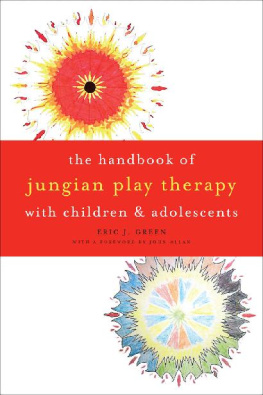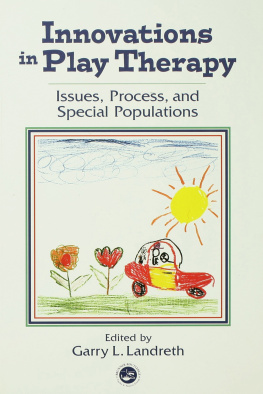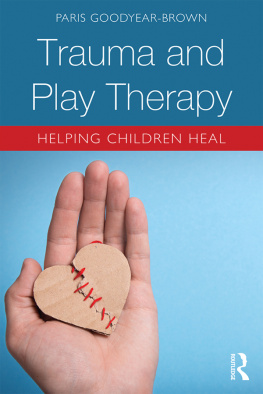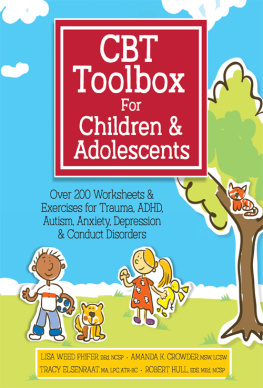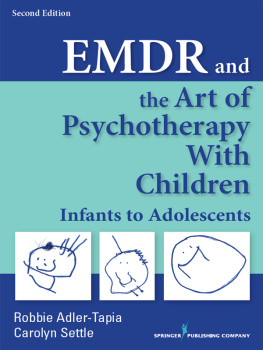Eric J. Green - The Handbook of Jungian Play Therapy with Children and Adolescents
Here you can read online Eric J. Green - The Handbook of Jungian Play Therapy with Children and Adolescents full text of the book (entire story) in english for free. Download pdf and epub, get meaning, cover and reviews about this ebook. year: 2014, publisher: JHUP, genre: Children. Description of the work, (preface) as well as reviews are available. Best literature library LitArk.com created for fans of good reading and offers a wide selection of genres:
Romance novel
Science fiction
Adventure
Detective
Science
History
Home and family
Prose
Art
Politics
Computer
Non-fiction
Religion
Business
Children
Humor
Choose a favorite category and find really read worthwhile books. Enjoy immersion in the world of imagination, feel the emotions of the characters or learn something new for yourself, make an fascinating discovery.
- Book:The Handbook of Jungian Play Therapy with Children and Adolescents
- Author:
- Publisher:JHUP
- Genre:
- Year:2014
- Rating:3 / 5
- Favourites:Add to favourites
- Your mark:
- 60
- 1
- 2
- 3
- 4
- 5
The Handbook of Jungian Play Therapy with Children and Adolescents: summary, description and annotation
We offer to read an annotation, description, summary or preface (depends on what the author of the book "The Handbook of Jungian Play Therapy with Children and Adolescents" wrote himself). If you haven't found the necessary information about the book — write in the comments, we will try to find it.
Eric J. Green: author's other books
Who wrote The Handbook of Jungian Play Therapy with Children and Adolescents? Find out the surname, the name of the author of the book and a list of all author's works by series.
The Handbook of Jungian Play Therapy with Children and Adolescents — read online for free the complete book (whole text) full work
Below is the text of the book, divided by pages. System saving the place of the last page read, allows you to conveniently read the book "The Handbook of Jungian Play Therapy with Children and Adolescents" online for free, without having to search again every time where you left off. Put a bookmark, and you can go to the page where you finished reading at any time.
Font size:
Interval:
Bookmark:
The Handbook of Jungian Play Therapy with Children and Adolescents
Eric J. Green
With a Foreword by John Allan

Note to the reader: The discussions and procedures herein are intended to acquaint readers with some of the techniques of Jungian Play Therapy that can be helpful in providing emotional and psychological care for children. It is intended to provide information to help children in general, and not to help any specific child. The views expressed are not necessarily the views of the author or of the publisher. This book is not meant to substitute for medical or psychological treatment, and treatment should not be based solely on its contents.
2014 Johns Hopkins University Press
All rights reserved. Published 2014
Printed in the United States of America on acid-free paper
9 8 7 6 5 4 3 2 1
Johns Hopkins University Press
2715 North Charles Street
Baltimore, Maryland 21218-4363
www.press.jhu.edu
Library of Congress Cataloging-in-Publication Data
Green, Eric J., author.
The handbook of Jungian play therapy with children and adolescents / Eric J. Green ; with a foreword by John Allan.
p. ; cm.
Includes bibliographical references and index.
ISBN 978-1-4214-1510-9 (pbk. : alk. paper) ISBN 1-4214-1510-0 (pbk. : alk. paper) ISBN 978-1-4214-1511-6 (electronic) ISBN 1-4214-1511-9 (electronic)
I. Title.
[DNLM: 1. Play Therapymethods. 2. Adolescent. 3. Child. 4. Jungian Theory. 5. Professional-Patient Relations. WS 350.4]
RJ505.P6
616.89'1653dc23 2014004980
A catalog record for this book is available from the British Library.
Special discounts are available for bulk purchases of this book. For more information, please contact Special Sales at 410-516-6936 or .
Johns Hopkins University Press uses environmentally friendly book materials, including recycled text paper that is composed of at least 30 percent post-consumer waste, whenever possible.
He was my North, my South, my East and West,
My working week and my Sunday rest.
W. H. Auden
This ones for you, Paul, my great mentor.
It was the BEST time of my life.
, by John Allan
Ten years ago I was lecturing at the University of North Texas in Denton, and a young man approached me at the end of the workshop, saying he had read much of what I had published, found it inspirational, and would like to offer his services to me as a researcher and cowriter. I thanked him for his comments and generous offer and said that right now I did not need any research or writing help. I added that I thought the most important thing was for him to do his own research, on play therapy with children and families, and to write up and publish his findings. I am very pleased to say that this young man was Dr. Eric Green and that this book, The Handbook of Jungian Play Therapy with Children and Adolescents, is the fruit of the combination of his playful energy and hard work over the past ten years.
Dr. Green has written a very important bookthe first of its kind to specifically address Jungian Play Therapy with children and families. In , the theory section of the book, Dr. Green shows a deep understanding of Jungs major constructs and how they both elucidate our understanding of the psyche and facilitate treatment. He provides a clear definition of terms and a discussion of four broad archetypal categories, and includes such areas as the shadow, anima-animus, the self, the ego-self axis, death-into-rebirth, and symbol amplification. He quotes from Jung and addresses issues of the transference-counter-transference and the importance of the therapist maintaining an analytical attitude throughout treatment. He pays attention to issues of time and space: the classroom, school, or community center represents ordinary time, but the playroom is the sealed vessel, the vas (the container), the place for sacred time, where the psychological transformation occurs. There are important rituals (or awareness) for entering and exiting this sacred space (the temenos) with the child and family members. Dr. Green shows how, through play and fantasy enactment in the playroom, emotions are expressed physically and/or symbolically, wounds are healed, and the child and family are freed of trauma, neglect, or developmental blocks to move forward and to grow.
What is impressive about this book is the sheer range of children, adolescents, families, and situations that Dr. Green has worked with. This book is truly a Handbook of Jungian Play Therapy with Children and Adolescents! His cases cover many childhood struggles and situations, including physical and sexual abuse, depression, bereavement, autism, witnessing of violence, ADHD, daydreaming, self-injurious behavior, and children and families affected by such natural disasters as flooding, hurricanes, and tornadoes.
The book will be very useful to many students and practitioners, because Dr. Green has been trained and is experienced in a wide range of theories and techniques. He integrates these in an overall Jungian frame that makes the new learning accessible to many therapists. One clearly sees how Dr. Green considers himself part of a team of mental health workershe consults with parents, teachers, and psychologists and articulates a treatment plan for each child and family. He uses evidence-based research findings to inform his practice. He sees the child alone in the playroom but then, when appropriate, incorporates parents and at times teachers in the room at later dates. He is not rigid or dogmatic but rather lets the child and the situation direct the flow of treatment. Dr. Green clearly enjoys children and has a very soulful practice.
The book is replete with useful symbolic activities to use with children, adolescents, and parents. As Dr. Green explains, the symbol contains emotions, and as the symbol evolves through play, so does the childs inner emotional world, and children begin to develop a rich internal life, which in turn facilitates learning, attending to schoolwork, and making friends. We see patterns in childrens play, movement from chaos to struggle, and finally resolution. At this point play therapy is no longer necessary and the child terminates treatment, often with a statement like I dont think I need to come and see you anymore.
The childs self-healing and creativity are encouraged through engagement in a variety of expressive arts techniques, including such therapist-suggested activities as coloring a mandala, sand worlds, directed and spontaneous drawings, self-portraits, journals and letter writing, guided imagery (including My Guardian Spirit), playing calming music tapes, and the reading of stories, myths, and fairy tales. Dr. Green selects the activities based on the psychological makeup of the child. For example, with a child who has Aspergers who spent a lot of time looking at himself in the mirror, he chose to read and discuss the Greek myth of Echo and Narcissus and then asked the child to sand a picture from the story. As the child worked in the sand, he made a spontaneous statement: Me and him both like mirrors. This timely intervention (the reading of the myth and the sand activity) opened up a whole new part of the child, which enabled him to disclose to Dr. Green and to change outside of the playroom with family members and other children.
In this case study and others throughout the book, Dr. Green gives many examples of his responses to and interpretations of the childs struggles. The reader becomes aware of Dr. Greens ability to empathically mirror the deeper emotions of the children and to provide the words and language to help children understand themselves and move forward into new growth. These are important counseling skills to demonstrate, so that readers are left with a new set of constructs and verbal skills for their own use. But at the same time, as shown in many of the cases, Dr. Green also models the ability of the therapist to remain silent and to witness the unfolding of the childs psyche without the distraction of words and interpretations.
Next pageFont size:
Interval:
Bookmark:
Similar books «The Handbook of Jungian Play Therapy with Children and Adolescents»
Look at similar books to The Handbook of Jungian Play Therapy with Children and Adolescents. We have selected literature similar in name and meaning in the hope of providing readers with more options to find new, interesting, not yet read works.
Discussion, reviews of the book The Handbook of Jungian Play Therapy with Children and Adolescents and just readers' own opinions. Leave your comments, write what you think about the work, its meaning or the main characters. Specify what exactly you liked and what you didn't like, and why you think so.

